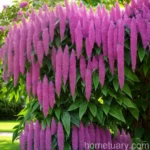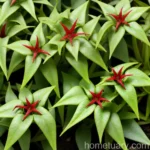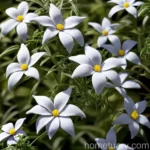Cupflower (Nierembergia scoparia ‘Mont Blanc’)
What is a Cupflower (Nierembergia scoparia ‘Mont Blanc’)?
Cupflower, scientifically known as Nierembergia scoparia ‘Mont Blanc’, is a charming and versatile perennial plant that belongs to the Solanaceae family. This plant is known for its delicate, cup-shaped white flowers and its ability to thrive in various garden settings. Cupflower is native to South America, where it can be found in the grasslands and open woodlands of Argentina, Brazil, and Uruguay.
Key Takeaways – Cupflower (Nierembergia scoparia ‘Mont Blanc’)
Here are some key takeaways about the cupflower (Nierembergia scoparia ‘Mont Blanc’) that we will explore in more detail:
-
Cultural Requirements: Understanding the cultural needs of the cupflower, including water, sunlight, fertilizer, and soil.
-
Uses: Exploring the various uses of the cupflower in landscaping and gardens.
-
Maintenance: Learning about pruning, propagation, and container gardening with cupflower plants.
-
Common Diseases and Pests: Identifying and managing diseases and pests that can affect cupflower plants.
-
Botanist’s Tips: Gaining insights and expert tips for successfully growing and caring for cupflower plants.
-
Fun Facts: Discovering interesting and lesser-known facts about cupflower plants.
-
Links to External Resources: Providing additional resources for further exploration of cupflower plants.
Now, let’s delve into each of these aspects to gain a comprehensive understanding of the cupflower and how to cultivate and care for it successfully.
Cultural Requirements
Water
Cupflower plants prefer moist but well-drained soil. During the active growing season, it is essential to provide regular watering, ensuring that the soil remains consistently moist. However, care must be taken not to overwater the plants, as this can lead to root rot and other water-related issues.
In hotter climates or during dry spells, the cupflower may require more frequent watering to maintain adequate moisture levels. During periods of high heat or drought, it is crucial to monitor the soil moisture and adjust the watering frequency accordingly.
Sunlight
When it comes to sunlight requirements, cupflower plants thrive in full sun to partial shade. Ideally, they should receive at least 6 hours of direct sunlight per day for optimal growth and abundant flowering. In regions with scorching afternoon sun, providing some afternoon shade can be beneficial, especially during the hottest months of the year.
Proper placement of cupflower plants in the garden or landscape, taking into account their sunlight preferences, is essential for ensuring healthy and vigorous growth.
Fertilizer
To support the growth and blooming of cupflower plants, it is beneficial to provide a balanced, all-purpose fertilizer during the growing season. This can help promote robust foliage and prolific flowering. A slow-release fertilizer applied at the beginning of the growing season can provide a steady supply of nutrients to the plants over an extended period.
Care should be taken not to over-fertilize, as excessive nutrients can lead to lush foliage at the expense of flowering. Following the recommended application rates and timing for fertilization can help maintain the overall health and vigor of cupflower plants.
Soil
Cupflower plants thrive in well-drained, fertile soil with a slightly acidic to neutral pH. Amending the soil with organic matter, such as compost or well-rotted manure, can improve its texture and fertility, providing an ideal growing medium for the plants.
Before planting cupflower in the garden or containers, conducting a soil test can provide valuable insights into the soil composition and pH levels. This information can guide the appropriate amending of the soil to create optimal conditions for the plants to flourish.
Uses
Garden and Landscape Ornament
Cupflower (Nierembergia scoparia ‘Mont Blanc’) is widely utilized as a decorative plant in gardens and landscapes. Its delicate, white cup-shaped flowers add a touch of elegance to flower beds, borders, and container plantings. The low-growing, spreading habit of cupflower makes it suitable for edging pathways, rock gardens, and mixed perennial beds.
Pollinator Attraction
The flowers of the cupflower plant are attractive to pollinators, including bees and butterflies. By incorporating cupflower into garden designs, it is possible to create a pollinator-friendly environment and support the health and diversity of local pollinator populations.
Container Gardening
Due to its compact growth habit and attractive flowers, cupflower is well-suited for container gardening. Whether grown in individual pots or as part of mixed container arrangements, cupflower adds a delightful charm to patios, balconies, and outdoor dining areas.
Ground Cover
In addition to its ornamental value, cupflower can serve as a ground cover in areas where low-growing, spreading plants are desired. Its ability to form dense mounds of foliage and flowers makes it a practical choice for filling in bare patches and carpeting the ground with its attractive blooms.
Erosion Control
The spreading nature of cupflower plants makes them effective for erosion control on slopes or in areas prone to soil erosion. By planting cupflower in such locations, it is possible to stabilize the soil and prevent the loss of valuable topsoil through erosion.
Maintenance
Pruning
Cupflower plants benefit from periodic deadheading to prolong the flowering period and encourage the production of new blooms. Removing spent flowers not only maintains the plant’s aesthetic appeal but also redirects its energy into further flower production. Additionally, any yellowing or damaged foliage should be pruned to promote the plant’s overall health and appearance.
Propagation
Cupflower plants can be propagated through division or stem cuttings. Dividing established clumps in early spring can help rejuvenate the plants, promote vigorous growth, and expand their presence in the garden. Stem cuttings taken from healthy, actively growing shoots can be rooted to create new cupflower plants, offering an economical means of propagation.
Container Popularity
As mentioned earlier, cupflower is well-regarded for its suitability in container gardening. Its compact size and attractive flowers make it a popular choice for adorning outdoor living spaces and adding visual interest to patio settings. When selecting containers for cupflower plants, it is important to choose those with adequate drainage to prevent waterlogged soil and maintain the plant’s health.
Common Diseases and Pests
Disease Diagnosis
While cupflower plants are generally resilient, they can be susceptible to certain diseases under unfavorable growing conditions. Common issues that may affect cupflower include powdery mildew, leaf spot, and root rot. Powdery mildew, characterized by a powdery white coating on the foliage, can be managed through good air circulation and the application of fungicidal treatments if necessary. Leaf spot, which manifests as dark spots on the leaves, can be mitigated through the removal of affected foliage and the use of appropriate fungicides.
Root rot, resulting from excessively wet soil, can be prevented by ensuring proper drainage and avoiding overwatering. Implementing sound cultural practices, such as watering at the base of the plants and providing adequate spacing to promote air circulation, can help minimize the risk of disease development.
Common Pests
In terms of pests, cupflower plants may encounter aphids, spider mites, and whiteflies. These pests can impact the overall health and vigor of the plants by feeding on the foliage and transmitting diseases. Regular inspection of cupflower plants for signs of pest infestations, such as distorted or discolored leaves, sticky honeydew residue, or visible insects, can facilitate early intervention and pest management strategies.
Botanist’s Tips
Planting Considerations
When planting cupflower (Nierembergia scoparia ‘Mont Blanc’), it is advisable to space the plants at least 12-18 inches apart to allow for adequate air circulation and prevent overcrowding. This spacing promotes good airflow around the plants, reducing the risk of disease incidence and fostering healthy growth.
Mulching Benefits
Applying a layer of organic mulch around cupflower plants can offer several benefits, including moisture retention, weed suppression, and temperature moderation. Organic mulches, such as compost, straw, or shredded bark, can help conserve soil moisture and reduce the need for frequent watering. Additionally, mulching aids in inhibiting weed growth, which can compete with cupflower for nutrients and water. Finally, mulch acts as a thermal insulator, protecting the plant’s root system from extreme temperature fluctuations.
Landscape Companions
Cupflower plants harmonize well with a variety of companion plants in garden and landscape settings. When selecting companion plants to grow alongside cupflower, consider species with complementary growth habits, color schemes, and cultural requirements.
For instance, pairing cupflower with low-growing annuals or perennials in complementary hues can create visually appealing combinations. Plants with contrasting foliage textures or shapes can also enhance the overall visual interest of the planting scheme. Selecting companion plants that share similar cultural preferences, such as water and sunlight requirements, can facilitate ease of maintenance and create cohesive garden compositions.
Fun Facts
-
Attractive Foliage: In addition to its delicate white flowers, cupflower is valued for its attractive, deep green foliage, which forms a dense mat of leaves, serving as an appealing backdrop for its blooms.
-
Wildlife Attraction: Cupflower’s nectar-rich flowers are known to attract a variety of pollinators, contributing to the biodiversity and ecological balance of the garden.
-
Low Maintenance: Once established, cupflower is relatively low maintenance, requiring minimal intervention and providing a reliable source of beauty in the garden.
-
Culinary and Medicinal Uses: While cupflower is primarily grown for ornamental purposes, some cultures have utilized the plant for its purported medicinal properties and as a culinary ingredient in traditional dishes and herbal remedies.
-
Cultural Significance: Cupflower has been mentioned in folklore and cultural traditions, where it may be associated with symbolic meanings and spiritual beliefs in certain regions.
Links to External Resources
To further explore the world of cupflower (Nierembergia scoparia ‘Mont Blanc’), consider the following external resources:
- Royal Horticultural Society – Nierembergia scoparia
- Gardening Know How – Cupflower Plant Care
- University of Florida IFAS Extension – Nierembergia Production Guide
- Missouri Botanical Garden – Cupflower (Nierembergia)
- American Society for the Prevention of Cruelty to Animals – Toxic and Non-Toxic Plants: Cupflower
These resources offer a wealth of information on cupflower cultivation, care, and its remarkable attributes, providing valuable insights for both novice and experienced gardeners.
In conclusion, cupflower (Nierembergia scoparia ‘Mont Blanc’) is a delightful and versatile plant with much to offer in garden and landscape settings. Its charming flowers, low maintenance requirements, and adaptability to various growing conditions make it an appealing choice for gardeners seeking an elegant and enduring addition to their outdoor spaces.
By understanding and meeting the cultural needs of the cupflower, utilizing it for its varied uses, applying sound maintenance practices, and being mindful of potential diseases and pests, gardeners can successfully cultivate and enjoy the beauty of cupflower (Nierembergia scoparia ‘Mont Blanc’).
I hope this comprehensive guide has provided valuable insights into the world of cupflower plants and offers inspiration for incorporating these delightful blooms into your own garden or landscape.
Happy gardening!















